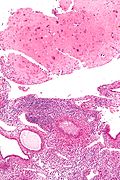Placental site nodule
(Redirected from Implantation site)
Jump to navigation
Jump to search
| Placental site nodule | |
|---|---|
| Diagnosis in short | |
 Placental site nodule. H&E stain. | |
|
| |
| LM | paucicellular hyaline material scattered cells (variable cell population: small to large cells with clear to eosinophilic cytoplasm), +/-multinucleation, no mitotic activity |
| LM DDx | invasive cervical squamous cell carcinoma, exaggerated placental site, fibrin +/-inflammatory cells |
| Site | endometrium |
|
| |
| Clinical history | previously pregnant |
| Symptoms | none |
| Prevalence | common |
| Prognosis | benign |
| Treatment | none |
Placental site nodule, abbreviated PSN, is a benign remnant of a placenta. It is seen on endometrial biopsies and hysterectomy specimens.
Implantation site redirects here.
General
- Benign.
- Intermediate trophoblast remnants from a previous gestation.[1]
- Usually an incidental finding.
Clinical:
- Usually asymptomatic.
- Vaginal bleeding. (?)
- Infertility. (?)
Microscopic
Features:[1]
- Paucicellular with hyaline material scattered cells.
- Variable cell population:
- Small-large cells.
- Clear to eosinophilic cytoplasm.
- +/-Multinucleation.
Notes:
- No mitotic activity.
DDx:
- Invasive (cervical) squamous cell carcinoma.
- Can be sorted-out with IHC (SCC will typically be: p16 +ve, MIB1 +ve).
- Exaggerated placental site.
- Different histomorphology than PSN; EPS:[1] syncytiotrophoblastic tissue, in cords/nests, no hyaline nodules.
- Fibrin +/-inflammatory cells.
Images
Case 1
Case 2
www
- PSN (ijpmonline.org).[1]
- PSN (gfmer.ch) - includes images from Jacob and Mohapatra.[1]
IHC
Features:[1]
- Inhibin alpha +ve.
- CK18 +ve.
- MIB1 low.
Other:
- p16 -ve.
Sign out
- CONSISTENT WITH MENSTRUAL ENDOMETRIUM (FRAGMENTED ENDOMETRIUM WITH SIMPLE GLANDS WITH APOPTOTIC CELLS, ABUNDANT NEUTROPHILS, CONDENSED ENDOMETRIAL STROMA (FOCAL) AND BLOOD). - PLACENTAL SITE NODULE AND DECIDUA. - NEGATIVE FOR HYPERPLASIA AND NEGATIVE FOR MALIGNANCY.
ENDOMETRIUM, BIOPSY: - PROLIFERATIVE PHASE ENDOMETRIUM. - BENIGN PLACENTAL SITE NODULE, SMALL. - NEGATIVE FOR HYPERPLASIA.
See also
References
- ↑ 1.0 1.1 1.2 1.3 1.4 1.5 Jacob, S.; Mohapatra, D.. "Placental site nodule: a tumor-like trophoblastic lesion.". Indian J Pathol Microbiol 52 (2): 240-1. PMID 19332926. http://www.ijpmonline.org/text.asp?2009/52/2/240/48931.





